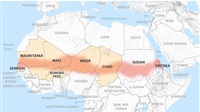Brotherhood’s delusional mullah-inspired dream destroyed by June 30th revolution
Tuesday 19/May/2020 - 04:36 PM

Nora Bandari
In one of the episodes of the Egyptian series “El-Ekhteyar” (The Choice) airing during Ramadan, a dialogue occurs between Egyptian terrorists Omar Rifai Sorour and Hesham Ashmawy in which the former spoke of his fascination with the 1979 Iranian revolution as the ideal model, regardless of sectarian discord.
This sheds light on the close relationship between terrorist groups and Iran’s mullah regime, as Sorour indicated that this model would have happened in Egypt if all Islamist currents turned toward Hazem Abu Ismail, the Islamist candidate for president at the time to whom Sorour had pledged his support.
Sorour had gone to Sinai after January 25, 2011 to join ISIS, but following differences with the leaders of the terrorist organization, he went to Libya in 2014 and formed several groups with Ashmawy, becoming a legal source for armed organizations until he was killed in 2018 in clashes with the Libyan National Army (LNA) in the city of Derna.
Intimate relationship
The relationship between the Brotherhood and Iran was not just established after the success of the Iranian revolution, rather it has historical roots. Former Brotherhood leader Tharwat al-Kharbawi explained in his book “Imams of Evil” that the relationship between the two parties began in 1938, when Khomeini visited the Brotherhood’s headquarters in Egypt and held meetings with the group’s leaders, during which he talked about ways to consolidate the relationship between the two parties.
The relationship was strengthened by Brotherhood terrorist philosopher Sayyid Qutb, who received Iranian cleric Navvab Safavi in 1954, and they talked about the necessity of bridging the gap between the Sunni and Shiite sects and working together to form a common front to confront what the Westernization of the Muslim world. Khomeini’s revolution was clearly influenced by Qutb’s ideology.
After the success of the Iranian revolution, the Brotherhood’s international branches sent delegations to congratulate late Ayatollah Ruhollah Khomeini, who had just returned to Iran to govern after gaining victory over the Shah's regime.
Iranian support
The mullah regime then started supporting the Brotherhood to implement a model similar to the Iranian revolution in Egypt. In 1981, the mullahs praised Khalid Islambouli, who was responsible for the assassination of late Egyptian President Anwar Sadat, as Tehran honored him by naming a street in the capital after him, which lasted until 2004, when it changed the street name in an attempt to improve relations with Egypt.
The Brotherhood has repeatedly praised Khomeini’s rule, seeing the 1979 revolution as the ideal model for eliminating tyrannical rule, standing by the oppressed, and confronting the West that was supporting the Shah's regime.
After the outbreak of the January 25, 2011 protests in Egypt, current Iranian Supreme Leader Ali Khamenei congratulated the Brotherhood on its success and gave a speech in Arabic encouraging them to complete their mission so that the Brotherhood could actually come to power in Egypt in 2012, when then-Iranian President Mahmoud Ahmadinejad visited Cairo.
In January 2016, security sources announced that documents were found at the Brotherhood headquarters in the Moqattam district in Cairo stating that a security apparatus similar to the Iranian Revolutionary Guards had been affiliated with the Egyptian presidency at the time with the support of Iran.







